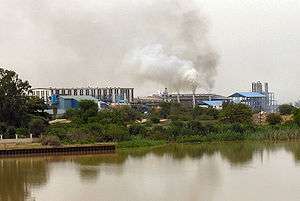Richard Toll
| Richard Toll | |
|---|---|
| Town | |
 | |
 Richard Toll | |
| Coordinates: 16°28′N 15°41′W / 16.467°N 15.683°W | |
| Country |
|
| Region | Saint-Louis |
| Department | Dagana |
| Population | |
| • Total | ~90,000 |
| Time zone | GMT (UTC+0) |
Richard Toll is a town in northern Senegal, lying on the south bank of the River Senegal, just east of Rosso. Originally a colonial town, it was named for the park of the Chateau de Baron Roger, laid out by botanist Jean Michel Claude Richard. A rice growing scheme was originally initiated by France's colonial development organisation, FIDES, in 1949 with an initial cultivated area of 6,000 hectares (14,830 acres). The town's main industry is sugar. Estimated population 2007: 70,000.
Marie Laforêt has a song about Richard Toll.[1]

History
Before Colonization there were only two villages Ndiangué, and Xhouma, which were inhabited by the Mbodi people descendants of Brack, and followers of the royal Walo Tradition. In 1817 the governor under colonial rule Schmaltz created L’Escale community on the Senegal River. In 1822, the new governor the Baron Roger sent a botanist and pépiniériste named Michelle Claude Richard to work in L’Escale and named it Richard’s Toll, meaning Richards Farm in local language. At this time there were 28 residents, and 1148 nomadic workers living in Toll. The size of toll then grew greatly in 1945 with the creation of the Mission Agricole du Senegal, which also brought other institutions such as a hospital, and chapel, and a school. There was then a rapid demographic growth in 1970 with the implementation of the Compagnie Sucriére Sénégalaise, which brought in around 15,000 inhabitants and brought about two phenomenon: the joining of the local villages, and the creation of new quartiers. By 1980 Richard Toll had six quartiers: Escale, Ndaingué, Ndiaw, Khouma Wolof, Khouma Peul, and Ndombo Alarba. Since then the city has grown and evolved into what it is today with the addition of quartiers such as Campement, Thiaback, GAE2, and Taouey.
Population
The latest estimate of the population available at the mayors office with was from 2005 which was at 46,547, however more recent estimates have put it around 90,000.
Demographic Breakdown
The latest gender, and age breakdown the mayors office had was from 2006, which stated 77.79% of inhabitants were between the ages of 0 and 34, 20.71% were between the ages of 35 and 74, and 1.19% were over the age of 75. Women constituted 52.01% of the population, and men 47.99%.
Neighborhoods
Richard Toll currently comprises 12 quartiers: Ndiao, Ndiangué, Richard Toll Escale, Campement et Nourou, Thiabakh, Ndombo Alarba, Khouma Gallo Malick, Gae II, Khouma Yakh Sabar, and Khouma Mbodiéne/Khouma Thiaréne.
Markets
There are two markets in Toll, the Richard Toll market, and the Xhouma Market. The Richard Toll market is a little larger than the Xhouma market. It is located in the main part of the city, and encompasses about 3 square city blocks although it is hard to tell where the market ends, and the regular city begins. I would estimate that there are over 50 established stores, and stands in the market. The Xhouma market is located on the eastern side of town in a primarily Pulaar area. It is located off the main road, as opposed to the Richard Toll market which is in more of a city grid.
Economic Activities
The main economic activities in Richard Toll are agriculture, fishing, animal husbandry, and commerce. Less popular economic activities are transportation, tourism, and artisanal goods.
Products for which Richard Toll is known
Richard Toll is most known for its sugar refinery, which is French owned and exports sugar to most of Senegal.
References
Coordinates: 16°28′N 15°41′W / 16.467°N 15.683°W